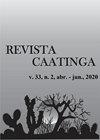丝兰Vellozia seubertiana(Velloziaceae)的微繁殖
IF 0.9
4区 农林科学
Q3 AGRONOMY
引用次数: 0
摘要
Velloziaceae是巴西巴伊亚州Chapada Diamantina高原Campos Rupestres山地热带草原区系的主要科之一,具有重要的观赏潜力和对气候变化的抗性。这个物种以其美丽的花朵和覆盖着叶鞘的茎而闻名,叶鞘可以在接触火时提供保护。然而,目前还没有关于其繁殖、保护和生理方面的资料来证明本研究的合理性。本工作的目的是建立一个小红花的微繁方案。将种子消毒后接种于半盐浓度(MS½)的Murashige和Skoog培养基(MS)中进行离体培养。体外培养的植株在添加6-苄基氨基嘌呤(BAP)的培养基中诱导发芽;0.00、4.44、8.88和17.76µM)和1-萘乙酸(NAA;0.00和2.22µM)。将获得的芽接种于含有活性炭(0.0和1.0 g L−1)和吲哚-3-丁酸(IBA;0.00和2.22µM),用于生根。有根植株在温室条件下驯化。在BAP含量为8.75µM、NAA含量为2.22µM的培养基中,器官发生苗数平均为5.7个。在体内生根阶段,活性炭对地上部和根长的影响最大。驯化植株在离体条件下移植60天后存活率达到75%。结果表明,微繁技术是一种很有前途的育苗技术。本文章由计算机程序翻译,如有差异,请以英文原文为准。
Micropropagation of Vellozia seubertiana (Velloziaceae)
ABSTRACT Velloziaceae is one of the main families in the floristic composition of the Campos Rupestres Montane Savanna ecoregion of the Chapada Diamantina Highland, Bahia, Brazil, and has species with significant ornamental potential and resistance to climate changes. The species Vellozia seubertiana stands out for its beautiful flowers and stems covered by leaf sheaths that ensure protection when in contact with fire. However, there is no information on its propagation, conservation, and physiology, which justifies this study. The objective of this work was to establish a micropropagation protocol for V. seubertiana. Seeds were disinfected and inoculated in Murashige and Skoog culture medium (MS) with half salt concentration (MS½) for in vitro establishment. Plantlets established in vitro were used to induce sprouting in MS½ supplemented with 6-benzylaminopurine (BAP; 0.00, 4.44, 8.88, and 17.76 µM) and 1-naphthaleneacetic acid (NAA; 0.00 and 2.22 µM). The shoots obtained were inoculated in MS½ containing activated charcoal (0.0 and 1.0 g L−¹) and indole-3-butyric acid (IBA; 0.00 and 2.22 µM) for rooting. The rooted plantlets were acclimated under greenhouse conditions. A mean of 5.7 shoots were generated through organogenesis in medium containing 8.75 µM of BAP and 2.22 µM of NAA. The use of activated charcoal resulted in the highest means for aerial part and root lengths in the in vivo rooting phase. Acclimated plants reached 75% survival at 60 days after transplanting to ex vitro conditions. The results indicate that micropropagation is a promising technique for the production of V. seubertiana seedlings.
求助全文
通过发布文献求助,成功后即可免费获取论文全文。
去求助
来源期刊

Revista Caatinga
AGRONOMY-
CiteScore
2.10
自引率
11.10%
发文量
67
审稿时长
6-12 weeks
期刊介绍:
A Revista Caatinga é uma publicação científica que apresenta periodicidade trimestral, publicada pela Pró-Reitoria de Pesquisa e Pós-Graduação da Universidade Federal Rural do Semi-Árido – UFERSA, desde 1976.
Objetiva proporcionar à comunidade científica, publicações de alto nível nas áreas de Ciências Agrárias e Recursos Naturais, disponibilizando, integral e gratuitamente, resultados relevantes das pesquisas publicadas.
 求助内容:
求助内容: 应助结果提醒方式:
应助结果提醒方式:


